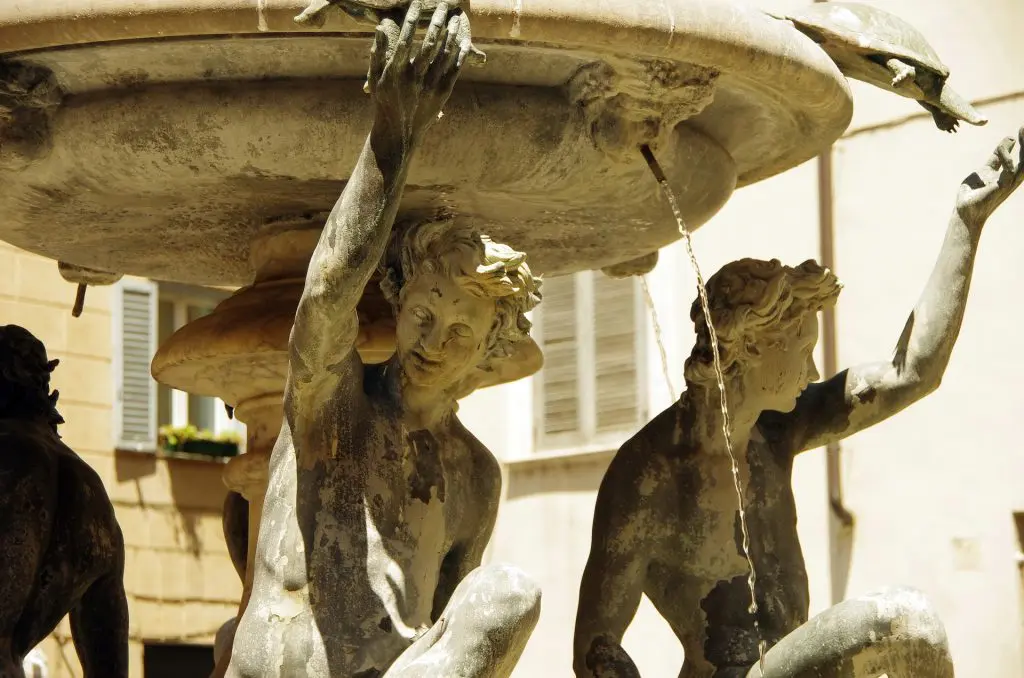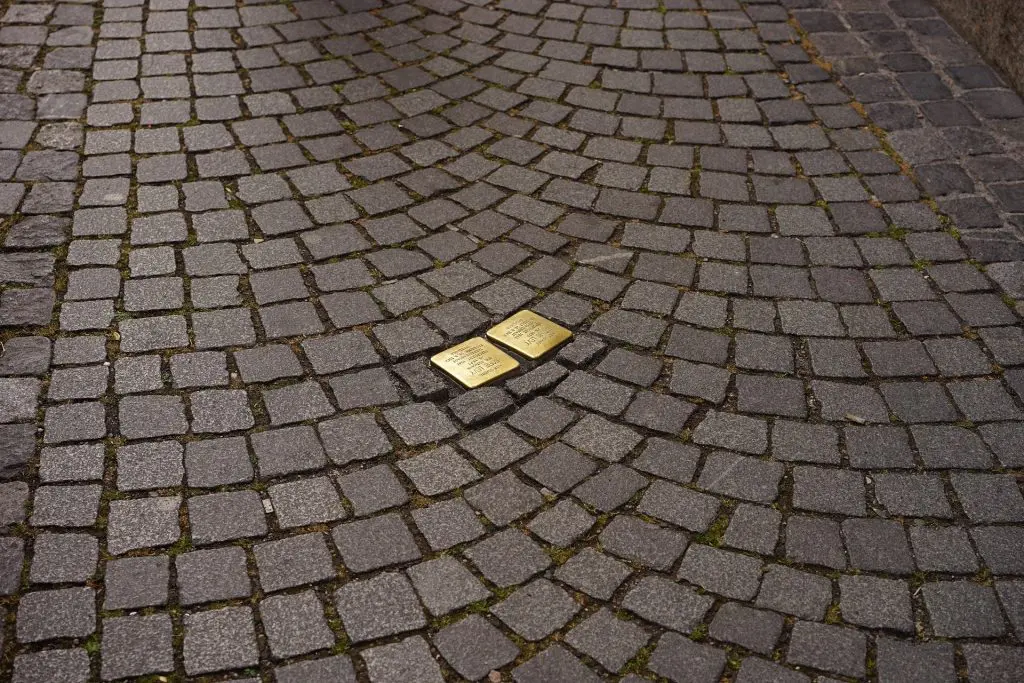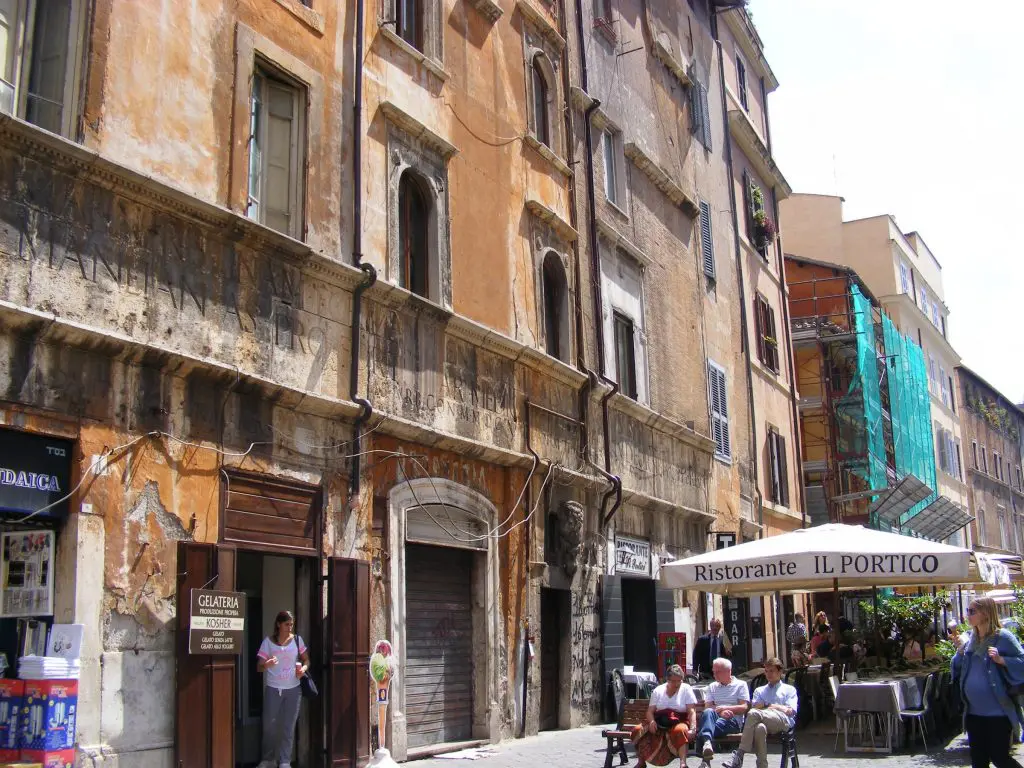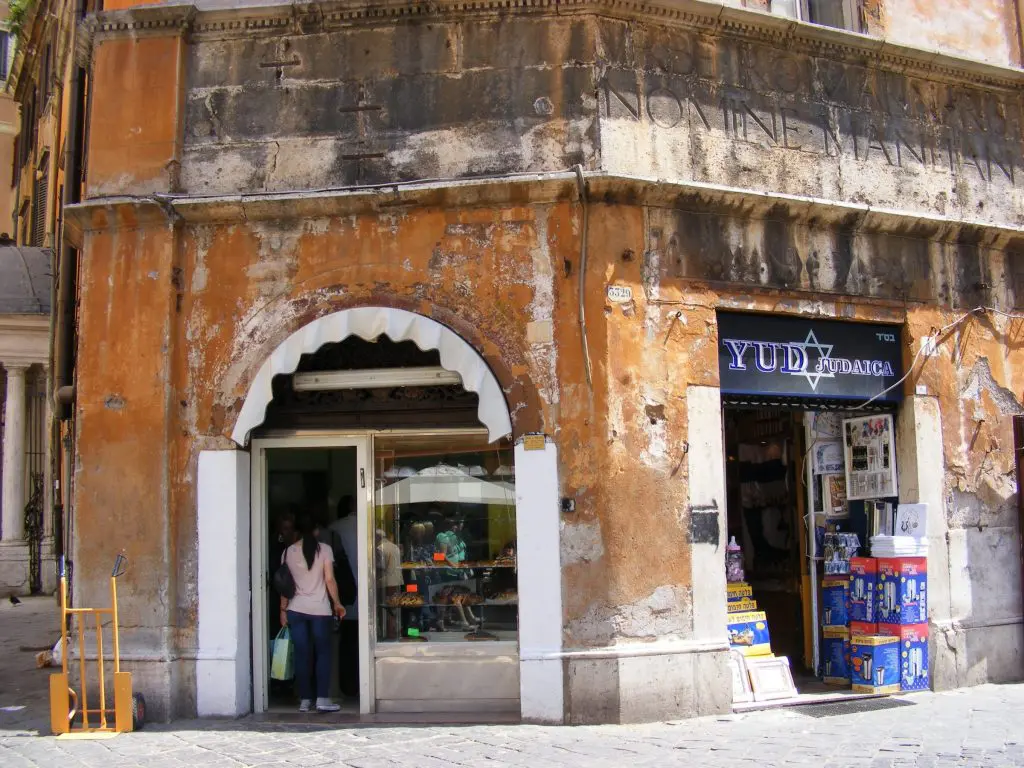The Jewish community is probably the oldest community of all in Rome. They consider themselves to be the most “Roman” among the Romans, and they are in fact not wrong, considering the so-called Ghetto (or, better, what we call today ghetto) has been the Jewish district for over 2000 years. Today, this Roman-Jewish community has its own dialect (known as Giudeo-Romanesco, a mix of Hebrew and Roman dialect) and its own culinary traditions.
It is among the biggest, most lively, and important Jewish communities in the world outside of Israel.
Jump to a section of this article
Quick history of the Ghetto

The Jewish ghetto in Rome was established in 1555, exactly on July 14th, by Pope Paolo IV, with the Cum Nimis Absurdum edict, that said: “Because it is absurd and inconvenient to the utmost degree that Jews, condemned for their faults by God to eternal slavery, can, with the excuse of being protected by Christian love, be tolerated living among us…”
The walls were then built in just a few months and the Jews were forced to live in this tiny district for over 300 years, up to 1870, when the Papal State ceased to exist, after the unification of Italy and the creation of the new Kingdom of Italy. The walls were completely torn down in 1888. Soon after the Synagogue of Rome was erected (1905) together with many new buildings. The ghetto was then reintroduced for the last time, in 1930, by the fascists.
It’s very interesting, while walking in the district, to notice the architecture. Since they had no space where to build, being confined by the river on the South and by the walls everywhere else, they had to start building apartments one on top of the other.
If you look attentively at the oldest buildings, you will notice that sometimes they are not the same from the bottom to the top, one floor is taller, one is shorter, one apartment looks wider, and so on. A tradition was that, when two people got married, their fathers were to build an apartment on top of the bride’s family’s home (so her mom could be close and help with the kids) as a wedding gift.
Today many of these apartments were torn down as they were not built properly, but you can still see some of them and their telltale irregular shapes.
The Synagogue
The Synagogue of Rome, or Tempio Maggiore, was built soon after the Unification of Italy (1870) when the Jewish community was “freed” and granted citizenship. The current Synagogue was built on the place of the building that housed the previous synagogue, which was quite a complicated structure, built by the Jews during the period of reclusion and with poor materials and no space, that hosted 5 “scolas” (temples) in a single building.
The Great Temple was finished in 1904 and yet, the first papal visit was made in 1986 by Pope John Paul II, with an unexpected (and definitely unprecedented) visit, that was also the very first papal visit to ANY Jewish site.
More than being the main temple of Rome, it’s today the second biggest Synagogue of Europe (after Budapest’s Great Synagogue), and it is also a cultural and organizational center for the Jewish community in Rome. It houses the office of the Chief Rabbi, as well as a Jewish Museum.

A story says that, despite all the beautiful descriptions of how the architecture of the Synagogue had to be, its shape (particularly the top part, that quite resembles a basilica’s dome) was changed due to the Pope’s pressures and that it was built to stand among the other buildings and the skyline of Rome, as the Jewish Community wanted, but it ought not be immediately recognizable as a Jewish Temple (it does look different than most of the other Synagogues in Europe). The following part of this “legend” is that, in World War II, it wasn’t destroyed during Black Saturday, because they didn’t recognize it to be the main Synagogue.
The truth is, Mussolini was an art-lover so he decided to not allow the Nazis to destroy it and just seized and closed it, hoping to make something else out of it at the end of the War, and it remained closed till the end of 1945.
Some stories and legends
One of the symbolic places of the Ghetto today is the Portico d’Ottavia, built by Cecilius Metella in 146 B.C. It was one of the five accesses to the area, chained and closed at night. During the day it was used by the Jews as a marketplace where they could sell their products (many of them were fishermen as during the day they could use the river to reach the sea and fish) both to the Jewish community and to the rest of Rome’s citizens.
A story says that on the right side of the building there used to be a marble fish and that the Jewish fishermen had to use the fish to measure the ones they had. If their own were bigger, in order to sell them they had to pay an extra tax, so what most of them used to do was to cut the head and/or the tail so their fish were smaller. Today, one of the most famous Roman soups is fish soup. The broth is made with the scraps of fish (mostly the heads). Guess where it came from!
In the back part of the Ghetto – behind the Synagogue and the main street – there is a tiny little square, very famous because of its fountain, called La Fontana delle Tartarughe (the turtles’ fountain). The legend around the fountain is that the duke Mattei (the family to which the square is dedicated) had lost a huge amount of money gambling and his future father-in-law didn’t want him to marry his daughter anymore. The duke, to show he was still rich and powerful, had the fountain built in just one night and right under his lover’s window. After his so desired wedding, the Duke decided to close the window so that no one else could use it in the future. If you look at the buildings, some of the windows are just painted on the walls and are not real windows.
Stumbling Stones
I told you that, if you look up at the buildings you will notice something unusual in their structure, but don’t just look at the sky while walking in the Ghetto area. If you look down, at the cobblestones, you will notice that some of them are made of gold. These are ‘Stumbling Stones‘. These particular stones are always found in front of doorways and are everywhere in the Ghetto and Trastevere mainly.
The stones are placed in memory of people who were captured and died during World War II. You will find their names, the date of birth, and the date of death, or either “unknown” because it isn’t known when or where they died as many families lost track of their loved ones once they were put on the trains to the labor or concentration camps. They are in front of doors to indicate that those people used to live in that building.
The interesting part of this story is that there is only one person who creates these stones. They are made by a German man from Berlin, Gunter Demnig. He is now quite old and has some help in his workshop, but still you can apply for your stone (whenever you want to have one in memory of your family member(s) who lost their lives in the war). These stones are everywhere in Europe, wherever there is or used to be a Jewish district, in all the countries hit by the war and nazism.
If you read them all, most of those people were captured and killed on October, 16th, 1943. This is the day remembered as Black Saturday. On that sad day 1,259 people (363 men, 689 women, and 207 children) were arrested and detained by the Gestapo. 1,023 of them were then confirmed to be Jewish and deported to Auschwitz. Of them, only 15 men and 1 woman survived.
Food and Culinary Traditions
There are many rules in the Jewish community around food, such as how to prepare food, how to cook it, how to process it, and so on, but I would like to focus on “what” to better explain the Roman-Jewish food you will find in the ghetto today.
So, first of all, even though the Ghetto doesn’t officially exist anymore, it’s a free area where everyone can live (even though it’s super expensive) and, of course, the Jewish community is not forced to stay there, we still call it “Ghetto” and whenever you say this word in Rome (but also in Italy in general) it’s not an insult and it’s not referring to a bad neighborhood, but in fact to one of the most beautiful districts of the city today.
As we said at the beginning, the Jewish community in Rome, being forced to live in a closed area for so many centuries, developed its own dialect and culinary traditions.
First of all, we have to say that ALL the Jewish restaurants, bars, gelaterie and pastry shops in the ghetto serve “kasherut” food. This means that they strictly follow the Torah rules on what you can or can’t eat and how. All these rules follow the principle that your blood is your soul and since what you eat goes in your blood, eating “impure” food will make your soul impure as well.
The first distinction is among: food that contains meat, food that contains milk and “parve” food (neutral, that don’t have neither meat nor milk). After this distinction, they then have some food they can’t eat within the categories, for example, they can eat only meat that is from both ruminant animals and with the “zoccolo fesso” (split hoof), so for example, it’s forbidden to eat pork meat, because the animal has the split hoof but it’s not ruminant.
They can’t “mix” milk and meat in the same meal and, before consuming the other element they have to wait till the end of digestion (so, if they had meat for lunch they have to wait till late afternoon to eat anything that contains milk, even desserts). This said, in the Ghetto you will find “milk kosher” restaurants and “meat kosher” restaurants, since they have to completely separate the two ingredients.
In both kinds of restaurants you will find some of the most famous Roman recipes (such as the carbonara pasta for example), readjusted to these rules. So for example, in a meat kosher restaurant you will be served a carbonara without guanciale (that’s pork meat). It will have a different kind of meat and a delicious egg cream without cheese of any kind (so no pecorino in the cream), but in a milk kosher place they will serve you a carbonara without meat (sometimes with zucchini cut in cubes) and with a very nice egg and pecorino cream.
All About the Artichokes
One of the most famous specialties of the Ghetto is actually what we consider today to be an “appetizer” or entree and is the artichoke. Artichokes in Rome are very common and very famous in the wintertime as they used to grow wild everywhere in the city (today they are quite expensive), they were used on everything and in every recipe: artichoke soups, artichokes on pizza, cut in slices in the pasta (or blended to make a nice creamy sauce), steamed artichokes with mint and garlic (Roman artichoke) and, finally, deep-fried artichoke (and this is the super world-wide famous Jewish artichoke, the Carciofo alla Giudia).
Recipe Time: How to Make Carciofo Alla Giudia
In order to make the carciofo alla giudia, you have to carefully select the variety of artichoke. The mammole are the best (the Roman ones), but any kind that has a large head will be fine.
You start by cutting the hardest part of the stem (leave a little bit though, up to an inch) and the hardest external leaves. In order to open up the artichoke, you have to press it upside down on a dish or board, paying attention to not break the leaves. You can also use your hands to open it a bit, like a flower. Warm some oil in a deep pan and put the artichoke in for around 10/12 minutes, turning it so that all sides will cook equally.
When it’s ready take it out and wait a few minutes for it to cool down. When it’s warm or cold, put it back in the pan for another 3 or 4 minutes and when it’s almost ready, spray it with some super cold water (be very careful here because the hot oil will splash everywhere when you spray cold water in!!). Put the artichoke on some absorbing paper, add some salt and pepper and voila!
Try the Cherry Pie!
Another specialty to try while here is crostata di ricotta e visciole (ricotta and sour cherries pie), they make it in a lot of bakeries around the city but the best one is definitely in the Ghetto, in the Boccione pastry shop (at the corner of the main street). This is a very particular place, it has no banners or signage and it has no working hours. They bake everything in the morning and when they finish what they have they just close and go home, so my suggestion is to go in the morning and have some pie for breakfast or as a midday snack!

Born and raised in Rome, Giorgia studied interpretation and translation in college, learning four languages and traveling extensively around Europe. Passionate about tourism and experiencing other cultures and traditions, Giorgia found work with a Roman tour company offering food and wine tours, and even trained as a sommelier. Excited to share her own culture and knowledge with others, and move beyond gustatory tourism, Giorgia joined JayWay, and proved to be an excellent fit.



